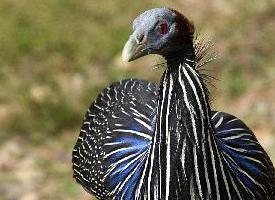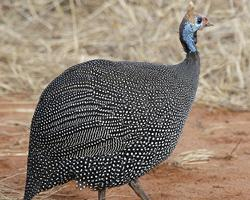
Súlyok és méretek
| Hossz | 61-tól 71-ig cm |
|---|---|
| Súly | 1-tól 1,65-ig kg |
Veszélyeztetettség
| Rettenthetetlen |
Állatleírás
The Vulturine Guineafowl, scientifically known as Acryllium vulturinum, stands out as one of the most striking and distinctive members of the guineafowl family. Native to the savannahs and arid regions of Eastern Africa, particularly in countries like Ethiopia, Kenya, Tanzania, and Somalia, this species showcases a unique blend of features that set it apart from its guineafowl counterparts.Characterized by its vibrant and elaborate plumage, the Vulturine Guineafowl is the largest species within its family, reaching lengths of up to 75 cm (29 inches). Unlike other guineafowl that possess a predominantly dark plumage, the Vulturine Guineafowl boasts a dazzling array of colors and patterns. Its body is cloaked in a striking blue hue, with a fine spattering of black and white spots decorating its lower back and wings. The chest and neck areas are adorned with long, elegant feathers that exhibit a deep cobalt blue, contrasted sharply against the stark white of its underbelly.
One of the most distinctive features of the Vulturine Guineafowl is its bare face and neck, which resemble those of a vulture, hence its name. This bare skin exhibits a bright blue coloration, complemented by a red eye ring that adds a touch of vividness to its overall appearance. The bird's head is crowned with a modest, casque-like structure, and its beak is short and stout, perfectly adapted for its omnivorous diet, which includes seeds, insects, and small invertebrates.
Behaviorally, the Vulturine Guineafowl is known for its gregarious nature. It forms large flocks, sometimes consisting of over a hundred individuals, which roam the savannahs in search of food. These flocks are highly social and maintain a complex hierarchy. Unlike other guineafowl species that prefer to scurry away into the underbrush at the first sign of danger, Vulturine Guineafowls tend to rely on their speed and agility, running swiftly across the ground with their heads held high, although they can fly short distances if necessary.
The breeding season for the Vulturine Guineafowl occurs during the rainy season, when food is abundant. The nest is a simple scrape on the ground, hidden among tall grasses or bushes, where the female lays a clutch of 4-8 eggs. The eggs are incubated primarily by the female for about 23 to 28 days, while the male stands guard nearby. Chicks are precocial, meaning they are born well-developed and are able to follow their parents and feed themselves shortly after hatching.
Despite their striking appearance and fascinating behaviors, Vulturine Guineafowls face threats from habitat loss and hunting. However, they are currently classified as Least Concern by the International Union for Conservation of Nature (IUCN), indicating that they are not presently at significant risk of extinction in the wild. Conservation efforts and protected areas are essential to ensure the continued survival of this remarkable species, allowing future generations to marvel at its beauty and complexity.
Hasonló állatok
Új állatfotók
Top 10 állat
- Dolphin gull (Leucophaeus scoresbii)
- Japanese macaque (Macaca fuscata)
- Stone loach (Barbatula barbatula)
- Galápagos tortoise (Geochelone nigra complex)
- Russian tortoise (Testudo horsfieldii)
- Diana monkey (Cercopithecus diana)
- Greek tortoise (Testudo graeca)
- Common flying dragon (Draco volans)
- Moustached guenon (Cercopithecus cephus)
- Galápagos penguin (Spheniscus mendiculus)
